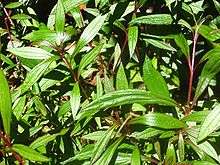Ayapana triplinervis
| Ayapana triplinervis | |
|---|---|
 | |
| Scientific classification | |
| Kingdom: | Plantae |
| (unranked): | Angiosperms |
| (unranked): | Eudicots |
| (unranked): | Asterids |
| Order: | Asterales |
| Family: | Asteraceae |
| Tribe: | Eupatorieae |
| Genus: | Ayapana |
| Species: | A. triplinervis |
| Binomial name | |
| Ayapana triplinervis (M.Vahl) R.King & H.Robinson | |
| Synonyms | |
|
Eupatorium ayapana Vent.[1] | |
Ayapana triplinervis (aya-pana, water hemp) is a tropical American shrub in the Asteraceae family. This plant has long slender leaves which are often used to make a stimulating medicine.[1] It contains Herniarin, a methoxy analog of umbelliferone, while its essential oil contains thymohydroquinone dimethyl ether.[2]
The flowers are pale pink and the thin, hairless stem is reddish in color.[1]
Names include aypana, aiapana, aiapaina, aipana, cagueña, curia, daun panahan, daun perasman, diapalma iapana, diarana-guaco, japana, japana-branca, sekrepatoe wiwir, pool root, white snakeroot, yapana,[3] Diapana, Zèbe cont'la fièv ', Zèbe vulnéraire, Zèbe à thé, Zèbe cout'la[4]
Tall water hemp is an annual weed, Amaranthus tuberculatus.
Description
An ascending, slender perennial. Leaves purple, subsessile, lanceolate, 3-nerved, acuminate, subentire, glabrous. Inflorescence a lax, few-headed corymb, heads pedicellate, about 20-flowered; flowers slaty blue. Constituents
- A rich source of naturally occurring coumarin chemicals.
- Leaves contain a volatile oil, ayapana oil, 1.14%.
- Plant yields cineol, alpha-phellandrene, alpha-terneol, ayapanin, ayapin, borneol, coumarin, sabinene, umbelliferone among many others.
- Hemarin, one of the coumarins is used as an anti-tumor remedy in herbal medicine.
- Phytochemical analysis of a methanolic extract yielded hexadecanoic acid (14.65%), 2,6,10-trimethyl,14-ethylene-14-pentadecne (9.84%), Bicyclo[4.1.0] heptane, 7-butyl- (2.38%), Decanoic acid, 8-methyl-, methyl ester (3.86%), 1-undecanol (7.82%), 1-hexyl-1-nitrocyclohexane (2.09%), 1,14-tetradecanediol (6.78%), Octadecanoic acid, 2-hydroxy- 1,3-propanediyl ester.
Usage
The herb is stimulant, tonic in small doses and laxative when taken in quantity. A hot infusion is emetic and diaphoretic. Decoction of the leaves is antiseptic and haemostatic; useful against various kinds of haemorrhage and to clean foul ulcers. An aqueous extract of the dried leaves is a cardiac stimulant. Fresh leaves are used by the Marma for cut and stomachache. Ethanolic extract of the aerial parts of the plant possess antibacterial and anti fungal properties.
Chemical constituents
The leaves contain an essential oil and the coumarins, ayapanin and ayapin, stigmasterol, esculetin methylene ether (the Methylene ether of esculetin), vitamin C and carotene. Ayapanin and ayapin are non-toxic and possess pronounced haemostatic properties and are effective when applied locally or when administered by subcutaneous injection or orally.
References
- 1 2 3 4 Ameenah Gurib-Fakim, Thomas Brendler (2003). Medicinal and Aromatic Plants of Indian Ocean Islands. p. 135. ISBN 978-3-88763-094-2.
- ↑ Anne Gauvin-Bialecki, Claude Marodon (November 2008). "Essential oil of Ayapana triplinervis from Reunion Island: A good natural source of thymohydroquinone dimethyl ether". Biochemical Systematics and Ecology. 36 (11): 853–858. doi:10.1016/j.bse.2008.09.006.
- ↑ Ayapana on www.rain-tree.com
- ↑ Avapana on www.ladograve.com (French)
